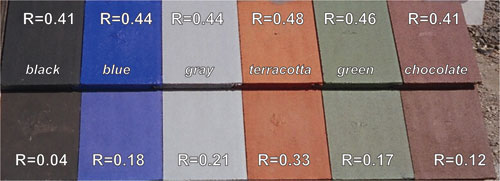Cool Roofs for Hot Projects
California − Title 24
Although cool roofs are not a mandatory measure for California's Building Energy Efficiency Code, Title 24, these regulations outline a clear prescription for the use of a cool roof as part of a building envelope. Under Title 24, if a cool roof is not used in situations where it is prescribed, the energy savings must be made up in another way, such as insulation with a higher thermal resistance (R-value), or windows with a lower thermal conductance (U-value), etc. Title 24 promotes energy efficiency by outlining energy standards and requiring compliance to a strict energy code. The code recognizes that cool roof surfaces can save 15 percent of the electricity needed to cool a building and that cool roofs reduce urban heat island effect causing an improvement in air quality.
A cool roof must be installed as part of prescriptive compliance to the code, or an allowed tradeoff among the building envelope components may be substituted. The performance method allows for the cool roof to set the energy budget for the proposed building. There are qualifications for conditioned and unconditioned spaces, but the main thrust of the regulations is that roof materials must obtain a third-party product rating by the CRRC, must be properly labeled and meet the minimum specified reflectance and emittance values set by the code.8 As of August 2009, Title 24 defines unique solar reflectance, thermal emittance, and SRI values based on the climate zone, slope, roofing material, and nature of the project. Generally, Title 24 cool roof requirements are as follows:
City of Chicago
The City of Chicago is one of many cities who have begun to mandate cool roofs as a way to mitigate the urban heat island effect. The Energy Conservation Code requires that new residential and commercial low-slope roofs have a minimum initial solar reflectance value of 0.72 or a three-year aged value of 0.50. New medium slope roofs (2:12 to 5:12) are required to have a minimum initial reflectance value of 0.15. Steep slope roofs (greater than 5:12), are exempt from any initial reflectance requirements. All roofing products must be rated by the CRRC or by ENERGY STAR.9
Rebates and Tax Credits
Because of the importance of reducing our carbon footprint and dependence on fossil fuels, there are numerous rebate programs and tax credits offered for energy efficiency measures, including cool roofing. Lists of rebate programs can be found online, as well as through local utility companies and the California Energy Commission. 9,10
The Many Faces of Cool Roofs: Dispelling Preconceived Notions of Cool Roofs
In the past, it was a common misconception that cool roofs only applied to flat, white surfaces, and were not appropriate where aesthetics were a concern. Others believed that cool roofs were much more expensive than standard roofs, and could only attain energy saving in hot climates. Today, these myths have been dispelled with the wealth of material and color options made possible by research and material technology advancement.
 |
Advancements in pigment technology increase solar reflectance across a broad spectrum. Photo courtesy of American Rooftile Coatings. |
Â
Researchers have created a new pallet of roofing materials that combine the properties of color with reflective surface materials that challenge some of the basic assumptions of what constitutes a cool roof. Numerous roofing materials are now rated with relatively high reflectance and emittance values, including high profile products, colored products and those applicable for steep sloped roofs. These products allow designers to realize the energy performance benefits of cool roofs without sacrificing design aesthetics.









